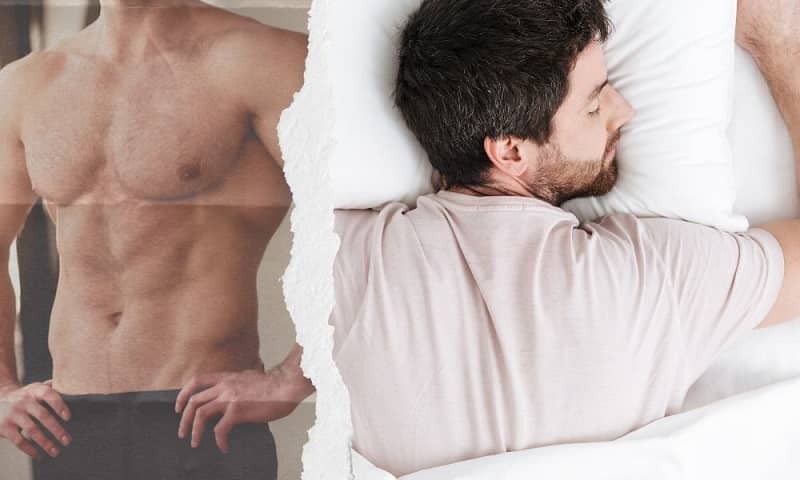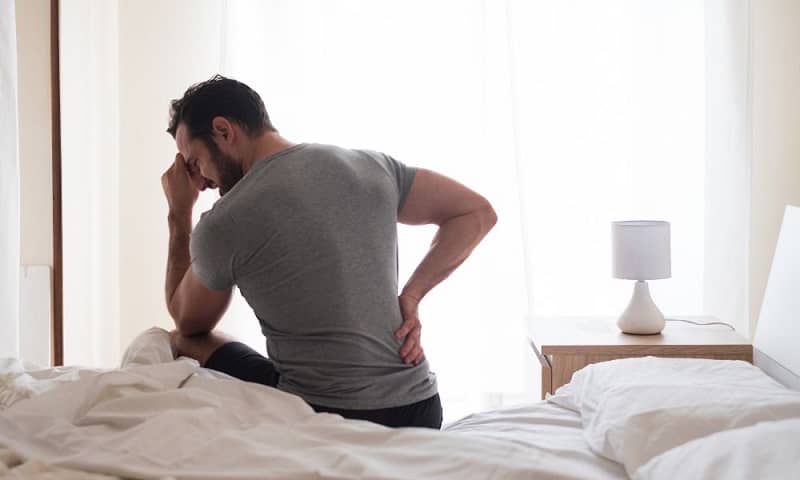Master the art of sleep to promote fast muscle growth after a strenuous training session!!
During sleep, the body rests to recover from the exhaustion of the last day, but that’s not all. For bodybuilders, athletes, and gym-goers, sleep is crucial for muscle recovery.
The body repair, re-heal, and recover from the muscle damage of the last day after heavy training.
While one may not pay attention, sleep posture matters for quality sleep and, in other words, muscle growth. Right posture during sleep can prepare you for another productive session and faster muscle growth.
In general, sleeping on the back is considered the best sleeping position for muscle growth, but it isn’t the only posture. This is the reason why this blog explores some of the best ways to sleep for muscle recovery, repair, and regrowth.
Whether a beginner or professional, the detailed information will be highly helpful.
4 Best Sleeping Positions for Muscle Growth

There are multiple unique ways to sleep, creating confusion in selecting the right one. Various sleep experts and fitness trainers have explored different popular muscle growth sleep positions.
They analyzed their actual ability to relax muscle tissue, keep the right position of organs, reduce stiffness, and lessen stress on the spine to recommend the best sleep position for muscle recovery.
Here’s a list of sleep positions that helps your muscles grow:
- Sleeping on your side
- Sleeping on your back, in a reclined position
- Fetal Position
- Sleeping on your back
Let’s explore each of them one by one.
1. Sleeping on Your Side
Most people prefer sleeping on the side as it is one of the most comfortable sleep positions and even it can aid muscle recovery.
However, when slumbering on the sides, put a firm pillow in between the knees to stabilize the posture. Doing so relieves stress on the spine and maintains its curvature.
This would keep your leg uplifted, maintaining the natural positioning of the spine, hips, and pelvis and lessening the potential stress from incorrect posture. With maximum relaxation, the sleep position would provide quality sleep and better muscle recovery and growth.
The best arm position for side sleeping ensures utmost comfort. So, examine which shoulder side sleeping works for you.
How to sleep on your sides:
- Sleep on any preferred side of your bed.
- For support, put a pillow under the neck or head.
- Also, part your knees a little and place a firm pillow between them.
Tips for Sleeping on Your Side:
- Choose a pillow that fills the gap between your head and shoulder properly.
- Don’t use a soft mattress as it can affect your spine.
- Lift your knees towards your chest to maintain a neutral spine.
- Put a firm pillow between your knees to reduce pressure.
- Don’t sleep on your arms as all night pressure can compress some nerves, which will affect your performance in the gym.
For additional support, use a pillow or sheets to fill the gaps between the body and the mattress. Or hug the pillow while sleeping on the side to maintain the alignment of the back.
2. Sleeping On Your Back In A Reclined Position
This sleeping position doesn’t stand the competition with the one mentioned above with respect to muscle recovery effect.
Nonetheless, it is still effective for fighting off stiffness, pain, and strain in the lower back area, which would help bodybuilders lift better.
How to sleep in a reclined position on your back?
- Lay on a recliner and sleep, or
- Sleep on a recliner bed, tilting it up at a comfortable angle.
- Place pillow in areas requiring extra support to make falling asleep easier.
Tips for Sleeping on Your Back (In A Reclined Position):
- Put pillows under your arms to reduce pressure from your shoulders and elbows.
- Use a soft lumbar support to keep your lower back in a neutral position.
- Put something under your knee as a support like a pillow or rolled-up blanket if you don’t have a support cushion.
- Avoid putting thick pillows behind your head as it can push your head much farther away which can strain your neck.
This can be the best sleeping position for bodybuilders with lower back issues and is great for optimizing sleep and assisting recovery. However, this position is not always recommended as it may not be suitable for everyone.
3. Sleeping in the Fetal Position
Another popular sleep position is a curled-up posture. It is applicable to folks with back problems or herniated disc issues. Sleeping in this posture provides relief when lying on the bed during the night.
So, fetal position sleep is great for recovery, muscle-building programs, and persistent back pain to get a painless stronger back. To make it more effective, do a child’s pose as in yoga. It works as a pre-stretch to release tension if existing soreness makes sleeping uncomfortable.
Thus, this further enhances the back pain-relieving and muscle recovery effect of the sleep position.
How to sleep in a fetal position?
- Lie on any side of the bed
- For support, put a pillow under the neck or head
- Bring your knees up to the chest, making the back aligned and straight
Tips for Sleeping in Fetal Position:
- Put a medium-firm pillow behind your head to keep it aligned with your body.
- Try to keep your posture slightly loose; otherwise, it can interfere with your breathing.
- Put a soft pillow between your knees to reduce pressure from them.
Experts do recommend doing a child’s pose (Balasana), but it is optional. If you are uncomfortable doing the pose, avoid it.
4. Sleeping on Your Back
This is the most popular and recommended sleep position for back muscle health. During sleep, the posture distributes weight across the entire body with minimal pressure points. Also, the alignment of the neck, head, and spine would be proper, making restorative sleep easier.
Not only does the back sleeping position leads to deep quality night sleep but promotes muscle recovery and regrowth as it relaxes the entire body. For extra support, place a pillow under the knees to keep up with the natural curve of the spine.
How to sleep on your back?
- Sleep on your back, making your head face the ceiling.
- Place a small pillow under your knees and one under your neck or head for support.
Tips for Sleeping on Your Back:
- Place a pillow under your back and knees to fill the gap between the mattress and your body.
- Sleeping on your back can be the best sleeping position for muscle growth if you keep your head and neck neutral.
- Make sure your chin is not touching your chest, but facing directly the ceiling.
- Choose a mattress and pillows that support your natural sleeping position.
- Practice breathing techniques to relax your muscles while lying on the bed.
Ensure that no gap remains between the body, mattress, and pillow. If there’s a gap under the lower back, use a pillow to fill it.
Sleeping position does affect muscle growth, recovery, and the next day’s productivity. Thus, the most relaxing sleeping position can be a breakthrough move to accelerate recovery. This would help improve fitness as well as physique drastically.
But like there are some good poses, there are also some worst ones that can aggravate the current problem. Checking them out becomes important from the point of precautions.
3 Worst Sleeping Positions for Muscle Growth

There are so many ways to sleep and relax the body, but not all of them are good. Some can maximize the existing soreness, inflammation, and discomfort. Thus, it becomes important to know what sleep positions to avoid.
Position 1: Half sitting and half lying down
For instance, imagine half sitting and half lying down on a bed using a pillow to support the lower back while your bottom remains straight.
Usually, people do so while watching TV, reading books, using phones, and sleeping halfway in it. This posture results in bowing or bending the neck for a long duration.
Having the habit to sleep in this position regularly can lead to many problems like swelling and pain in the shoulders, pain around the neck, lower back pain, and so on.
On top of that, the sleeping position in no way relaxes the body. Instead, it subjects the physique to discomfort and stiffness, which can worsen already existing muscle soreness. This makes the sleeping position a must-avoid for bodybuilders.
Position 2: Sleeping on your front
The urge to jump on your front onto the bed to let relaxation take over is high, but the sleeping position is one of the worsts. It compromises the flow of breathing and even leads to irregular curvature of the spine.
Also, you might tilt your head on one side during sleep, which again affects the curvature. This can cause multiple problems like back pain, pain and inflammation in neck muscles, and so on.
Also, it doesn’t do much to relax the arms, back, and lower body, making it bad for muscle recovery. Even if you want to sleep in the position, a short duration would be fine. Put a pillow underneath the abdomen, chest, or other areas for support, which would make sleep a little comfortable.
Position 3: Resting your head on your upper arm
When sleeping on their sides, people tend to rest their heads on their upper arms. This leads to continuing pressure on the upper arm where the radial nerve lies, which poses the chance of nerve damage when done regularly.
In fact, the most common problem arising due to the sleep position is wrist drop (a condition where it is tough to uplift the affected hand). Moreover, the condition occurring due to prolonged pressure on the radial nerve is known as honeymoon palsy or Saturday night palsy.
Usually, the mentioned problems aren’t serious and naturally fade away, but recovery duration would vary from person to person. Given the chances of inflammatory encounters, it is best to skip these sleeping postures.
Worst sleeping positions seem to cause muscle stiffness, discomfort, and pain, and they do no good for sleep quality. Overall, for muscle growth and repair, experts have tagged them as the worst ones for obvious reasons.
Though everything seems to be answered on the best sleeping position for muscle growth, there are a few queries left. The next segment discusses some of them.
FAQs
There is more to the doubts related to sleep, sleeping position, and muscle recovery. This section mainly addresses them.
Q1. Should you sleep on the floor for better muscle recovery and growth?
Sleeping on the floor can be great for recovery, particularly after a strenuous workout session. However, it is more applicable for folks, who don’t usually move a lot during their sleep.
Moving less ensures continued blood flow, resulting in better muscle nourishment. The nutrients and oxygen flow to different muscle tissue continuously without disturbance. For full recovery, muscle requires nutrient-rich blood and oxygen. Sleeping on the floor can fulfill the requirement.
This was a possible scientific explanation that could be possible, but whether it works or not hasn’t been explored scientifically. It is just an observation through records, reports, and deductive reasoning.
Q2. Do you need a pillow to sleep?
Pillows are an obvious part of one’s sleep routine, but it has been the last several thousand years that have made pillows a nighttime useful item. But if asking about its importance while sleeping, it depends on individuals and their sleeping habits.
Some sleep positions require pillows to provide comfort to the body and maintain the natural curvature of the spine.
So, it becomes important when sleeping on the sides and in the fetal position. Irrespective of the sleeping position, using pillows for additional support, when you need it, is necessary to avoid strain.
Q3. Is it okay to switch sleeping positions while sleeping?
Nobody wakes up the same as they have slept. It is obvious to move when sleeping, whether a little or a lot. However, initially sleeping on the back and later on sleeping on the sides, to later switch to the fetal position can be a bit bad for the body.
When switching positions when in slumber, the pillows aren’t always in the right spot to provide comfort. This is the reason switching positions while sleeping is going to be bad for muscle growth.
Conclusion
Sleep is the time when the body recovers. So, paying attention to the sleep position can be good for boosting muscle relaxation.
Knowing the best sleeping position for muscle growth for athletes, bodybuilders, and gym goers as well as the worst sleeping postures is necessary.
The key is to ensure the entire body relaxes and the spine maintains its curvature. Place pillows wherever extra support is necessary.
The emphasis on the right sleeping position is huge because it can be great not only for muscle growth but for better spinal health, posture, circulation, joint flexibility, and mobility too.
On top of that, it improves cell hydration and loosens muscle fascia. All of these advantages can accelerate recovery after exhaustive workouts. So, did you find the blog useful?
Do you know of any other sleep positions for optimum muscle growth and relaxation? Do share your thoughts in the comments section.
READ NEXT: Best Sleep Supplements for Muscle Recovery
